Crown Prince Wilhelm (ship, 1881)
|
Crown Prince Wilhelm paddle steamer in Holzminden
|
||||||||||||||||||||
|
||||||||||||||||||||
|
||||||||||||||||||||
|
||||||||||||||||||||
|
||||||||||||||||||||
The paddle steamer Kronprinz Wilhelm was built in 1881 in the Blasewitz shipyard. It was under the name of Meissen with the hull number 38 to set keel . From 1907 the ship was operated by the Oberweser Dampfschiffahrts Gesellschaft under the new name Kronprinz Wilhelm on the Weser and was decommissioned in 1967. The central nave has been in the German Maritime Museum in Bremerhaven since 1968 .
history
The time until 1907

|

|
|
|
Paddle steamer Meissen in front of the Italian village (between 1882 and 1894, left) and in Blasewitz (right)
|
||
After commissioning as a smooth deck steamer on May 15, 1881, the ship drove for the Saxon-Bohemian Steamship Company (SBDG). In 1887 the paddle wheels were converted into patent paddle wheels. On this occasion it also received a two-flame tube suitcase boiler from the Prague mechanical engineering company vorm. Ruston & Co. On March 17, 1907, the ship was sold to the Oberweser-Dampfschiffahrtsgesellschaft FW Meyer Hameln (OWDG). Before delivery, extensive work was carried out on the ship in the Laubegast shipyard . In addition to the construction of an upper deck , the ship also received a steam steering engine .
The time after the sale
On May 5, 1907, the ship was transferred downstream across the Wadden Sea into the Weser . From May 13, 1907, it drove there under the new name Kronprinz Wilhelm on the 135 km long Hann. Münden - Hameln , where 26 stations were served. Name giver was Wilhelm of Prussia . In 1925/26 the ship was rebuilt.
At the Arminius shipyard in Bodenwerder , the ship was lengthened by 5.80 m to 55.94 m. The width over the wheel arches was now 9.20 m. Furthermore, the typical double windows were replaced by simple windows. The steam engine was rebuilt and a cylinder boiler from the scrapped Weser tug Germania was installed. At the end of the Second World War , the ship was buoyant, but not operational. After being repaired, it resumed regular service on June 16, 1946.
After the bankruptcy of the OWDG in 1964, the ship sailed from 1965 under the flag of Personenschiffahrt Oberweser GmbH .
The long-time captain was Fritz Kumleh, who served on the Crown Prince Wilhelm from 1913 to 1968 .
Decommissioned in 1967 and a museum exhibit in Bremerhaven
In September 1967 the ship was decommissioned due to its high coal consumption, which was 150 kg / hour and was no longer up-to-date, and was transferred to Bremerhaven in September 1968 . There fore and aft ship were scrapped. The central nave with boiler, engine and paddle wheels, however, was returned to the original state of the Meissen and incorporated into the museum holdings of the German Maritime Museum, where it can be viewed as an accessible original exhibit. Equipped with an electric drive, the steam engine can be set in motion.
The steam engine
The steam engine comes from the Meissen built in 1857 . It was an oscillating low-pressure two-cylinder twin steam engine from the English mechanical engineering company John Penn and Sons with an output of 110 hp. The two-flame tube suitcase boiler built by Prager Maschinenbau AG in 1878 also comes from Meissen . This was replaced in 1887 by a new two-flame tube suitcase boiler. In 1925/26 the machinery was completely rebuilt. With components of the Prague mechanical engineering company vorm. Ruston & Co., the engine was converted into an oscillating two-cylinder compound steam engine with an output of 135 hp. The now installed cylinder boiler came from the wrecked Weser tug Germania .
Other ships named Kronprinz Wilhelm
In 1901, the Crown Prince Wilhelm was launched as a passenger ship of the North German Lloyd (NDL) in the so-called Imperial Class (Schnelldampfer class) for liner shipping on the Transatlantic Passage Bremerhaven-New York. The large-line ship of the Imperial Navy SMS Kronprinz was renamed SMS Kronprinz Wilhelm on June 15, 1918 .
Captains of the ship
- Heinrich Ehregott Müller 1882–1883
- Carl Gottlob Thieme 1884
- Heinrich Ehregott Müller 1885
- Friedrich Ignatz Beckel 1886
- Friedrich Carl Kunze 1887-1892
- Ernst Julius Cave 1893–1896
- Gustav Hermann Protze 1897
- Carl August Helm 1898–1901
- Friedrich August Winkler 1902–1905
- Gustav Eduard Fischer 1906–1907
literature
- Hans Rindt: The "White Fleet" Dresden. From the history of the Upper Elbe passenger shipping . In: Deutsches Schiffahrtsarchiv 3 (= writings of the German Maritime Museum . Volume 12 ). Oceanum-Verlag, Wiefelstede 1980, ISBN 3-7979-1523-3 , p. 69-114, especially pp. 90 f . ( online at the German Maritime Museum [PDF; 5.3 MB ]).
- Address and business manual of the royal capital and residence city of Dresden 1882 to 1884
- Shipping calendar for the Elbe area from 1885 to 1907
Web links
- Cardboard construction: DSM Kronprinz Wilhelm (technical data)
- Photo of Crown Prince Wilhelm from 1958 during a trip on the Oberweser near Reileifzen
- List of paddle steamers of the Saxon-Bohemian Steamship Company
Individual evidence
- ↑ The postcard comes from the postcard publisher Ottmar Zieher .
- ↑ a b Article in the Hamburger Abendblatt from June 8, 1968: "Crown Prince Wilhelm" ate too much coal . The reference to the ship as the oldest paddle steamer at the time is incorrect in the article introduction. The city of Wehlen , which still travels on the Elbe , was built in 1879.
- ↑ The MEISSEN paddle steamer: pleasure for the passengers - dangerous work for the crew. German Maritime Museum, accessed on June 13, 2019 .

